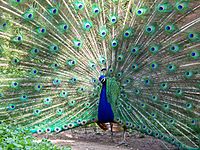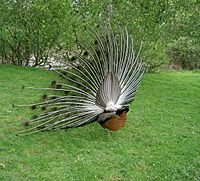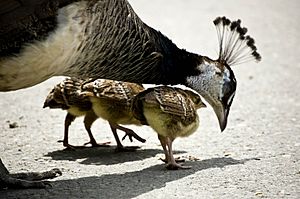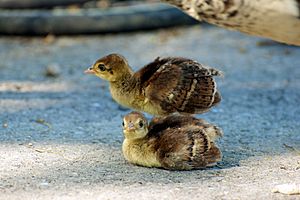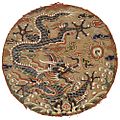Peafowl facts for kids
Quick facts for kids Peafowl |
|
|---|---|
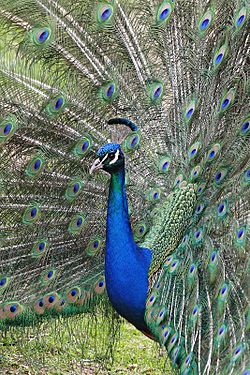 |
|
| Indian blue peacock | |
| Scientific classification | |
| Kingdom: | |
| Phylum: | |
| Class: | |
| Order: | |
| Family: | |
| Genus: |
L, 1758
|
A peafowl is a beautiful bird that belongs to the Phasianidae family. It is a close relative of the pheasant.
There are two main species of peafowl. These are the Asiatic peafowl (Pavo) and the Congo peafowl (Afropavo congensis). The Congo peafowl is special because it is the only pheasant family member that comes from outside Asia.
Male peafowl, called peacocks, can have up to 150 bright, long feathers on their tails. People have admired peafowl for their beauty for hundreds of years. They were also hunted for their meat. Today, peacocks are often seen in parks and gardens.
Contents
Plumage
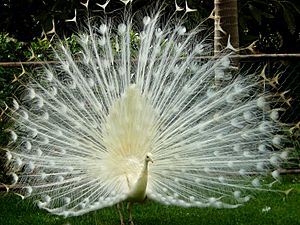
The Indian peacock has shiny blue and green feathers. The green peacock has green and bronze body feathers. Female peafowl, called peahens, are as big as males. However, they do not have the long, fancy tail or head feathers.
A peacock's "tail" is actually made of very long feathers that cover its real tail. These feathers have special "eyespots" on them. You can see these spots best when a peacock fans out its tail. Both male and female peafowl have a crest of feathers on their heads.
The Indian peahen has dull grey, brown, and green feathers. Females also show their feathers to warn other females or to signal danger to their young.
Green peafowl are different from Indian peafowl. The male green peafowl has green and gold feathers with black wings. Unlike Indian peafowl, the female green peahen looks similar to the male. She just has shorter tail feathers and less shine.
The Congo peacock male does not fan out his tail coverts. He uses his actual tail feathers when trying to attract a mate. These feathers are much shorter than those of the Indian and green species. Their eyespots are also much less clear. Females of the Indian and African species are dull grey or brown.
Young peafowl, called chicks, have colors that help them hide. They are usually yellow or tan, with patches of darker brown or light cream.
Colour and Pattern Variations
When Indian and Green peafowl have babies together, the babies are called Spaldings. These hybrid birds are strong and can have their own babies. Spaldings that look more like green peafowl can handle cold weather better. This is good because green peafowl don't like the cold.
There are many different colors and patterns of Indian Blue peafowl. Breeders have named hundreds of these variations. Some patterns include solid-wing (where stripes are one color) or pied (birds with patches of white). Some color variations are white, purple, bronze, and midnight.
Sometimes, peafowl are born with white feathers. Most white peafowl are not albino. Instead, they have a genetic condition called leucism. This condition stops their color cells from developing properly.
Male Peafowl
Appearance
Male peafowl, known as peacocks, have long, very colorful feathers. Female peafowl, called peahens, have shorter, brown feathers.
Habits
Eating Habits
Peafowl like to eat many kinds of green plants. This includes flowers, vegetables, and grass. They also eat wheat, cracked corn, or wild game feed. Peafowl are omnivores, meaning they eat both plants and animals. They enjoy insects, small snakes, and lizards.
They can handle cold weather if they have a dry place to perch. This spot must be out of the wind and rain. Dry dog and cat food are good winter meals for peafowl. They especially love petunias and other potted plants. They will eat them all, leaving only a small green circle.
Peafowl can learn to come to a certain spot at specific times for food. Feeding them a little in summer helps them know where to go for food in winter.
Origin
Peafowl originally come from Southeast Asia, including India and Pakistan. They were brought to Europe a long time ago. They can get used to colder places.
Mating
The male peacocks grow their long, colorful tail feathers during winter. This makes them ready for the mating season in early spring. During this time, each male finds his own area. The male calls to the females to come and see his dance.
He shakes his tail feathers, which hold up his fanned-out plumes. He stamps his feet and turns around. His call is loud and sounds like a woman screaming to some people. It often has three parts. After the mating season, the tail feathers naturally fall off.
A peacock's display is a great example of sexual selection. This means that traits that help an animal find a mate become more common over time.
Female Peafowl
Female birds, called peahens, are soft brown and grey. They have white chests and bellies, with some light green on their necks. Their colors blend well with weeds and grass. This makes them almost invisible when they are nesting on the ground.
Mothering
The peahen teaches her chicks what to eat. She points her beak at a bug, grain, seed, or leaf. Then she makes a low "grock" sound. The chick touches its beak to its mother's. It follows her beak to the tip and eats what she points at.
Chicks can learn to eat from a hen of another species. However, unlike baby chickens, peachicks need to be shown what to eat. Chicks hatched without a mother can starve if no hen teaches them.
Besides the "eat this" sound, the female has a special call for a missing chick. It is a "where are you" call, sounding like "hoo-hah." This two-toned call can go on for hours if a chick is lost.
Reproduction
A peahen lays two to six eggs in the springtime. Once all the eggs are laid, she sits on them for about 30 days to hatch them. She leaves the nest only once or twice a day to eat and drink.
Often, the female will make a loud "trouble" call when she leaves the nest. This is a quick "cuk, cuk, cuk, cuk" sound. It helps attract predators away from her nest.
Chicks
Once the chicks hatch, the mother leads them away from the broken eggshells. The smell of the shells can attract predators. Chicks can flutter their wings a little within hours of hatching. In a few days, they can fly up into trees for safety. They go to lower branches first and then move higher. They prefer high, protected branches.
The chicks roost on either side of the peahen. She spreads her wings to cover them at night. This protects them from rain, hail, and owls. Chicks start to grow their "crowns" when they are only a few weeks old. It takes about a year for them to reach full size. However, it may take three years for them to be old enough to have their own babies.
Both male and female chicks are born with the same feathers. About nine to twelve months after hatching, the males' necks start to turn peacock blue. Their amazing tail feathers take about four years to grow to full size.
Images for kids
-
A green peafowl (Pavo muticus).
-
A peacock in a flask, from an old book about alchemy
-
A peacock served in full plumage (from a painting by Jan Brueghel the Elder, 1618)
-
A round design with a dragon, from Qing-dynasty China. Peacock feather barbules were used to highlight the dragon's scales.
-
Lord Kartikeya with his wives on his peacock mount
-
In a 1486 painting by Carlo Crivelli, a peacock sits on a roof above the praying Virgin Mary
-
Painting by Abbott Thayer and Richard Meryman for Thayer's 1909 book, suggesting the peacock's plumage was camouflage
-
Common Pea Fowl, by John Gould, c.1880 Brooklyn Museum
-
Syrian Bowl with Peacock Motif, c. 1200 Brooklyn Museum




